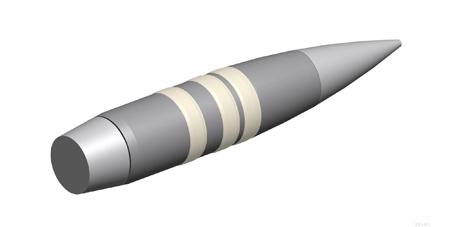The role of the sniper is to hit multiple objectives quickly and with lethal effectiveness, since an un-eliminated target could jeopardize the security of the troops, also revealing their position. The acquisition of moving targets in unfavorable conditions, such as strong winds and dusty terrain (normal in Afghanistan) is extremely difficult with current technologies.
The "Exacto" program, acronym for Extreme Accuracy Tasked Ordnance developed by California Teledyne Scientific & Imaging on behalf of Darpa, the US Defense Advanced Research Projects Agency, could radically change the role of the sniper, equipping him with bullets in able to change direction. The goal is to revolutionize the accuracy of sniper rifles by developing the first small-caliber guided projectile.
The bullet chosen is the '50 caliber. The system combines a fin stabilized projectile with extremely maneuverable flight control and a real-time optical guide. The bullet will have the ability to change course during the flight to compensate for any unexpected factors that could deviate its trajectory.
The "Exacto" program has already entered phase two. Phase one included the design, integration of the weapon system, demonstration of air controls, energy sources, optical guidance systems and sensors. Phase two provides an operational theater test to improve the performance of the entire system.
The entire program is covered by military secrecy. However, DARPA has announced that the tests performed so far have been successful. The tests were performed in February and last March. In both tests the bullets changed direction, while in the last one the target with remote-controlled detour was even hit.
Snipers generally operate in teams of two men (both chosen shooters): the real "sniper" and the "spotter", the one who locates the target. The US Department of Defense believes it is "fundamental" for snipers to hit targets as quickly and as accurately as possible, which is why it was decided to invest in Darpa's program.
The problems, however, are manifold.
Meanwhile it would be appropriate to understand how this technology can prove to be a success on the field. Certainly not a moral problem (considering the current intelligent guide to bombs), but a feasibility of the system. Meanwhile, the "Sniper" teams carry a large amount of material: one wonders how it will be possible to also bring the driving system. Then we should understand how a bullet that travels faster than sound can be diverted with human reflexes.
Finally, the last unknown factor is in some ways the most dangerous. Because while it is true that the ideas precede that the technology of the time can really achieve, on the other it is feared, if "Exacto" becomes operational, the possible loss of sensitive material. The mere thought of equipping the enemy (even through a process of reverse engineering) with intelligent bullets could even overcome the benefit of possessing such a weapon system. A terrorist with such offensive abilities would be a nightmare.
Tests in operational theaters, as is happening for exoskeletons and for all new weapons developed by Darpa, will be performed by Navy Seals.
The bullet from Sandia National Laboratories
Sandia National Laboratories, a subsidiary of Lockheed Martin, developed in 2012 a four-inch bullet with an optical sensor capable of detecting a laser beam on a target. The bullet flies straight thanks to its aerodynamically stable design, with small fins that allow it to fly without rotation, just like a dart thrown from a crossbow. Tests have shown excellent bullet shooting accuracy capable of reaching speeds of Mach 2,1.
Perplexities, however, have arisen due to the use of the laser guide: the beam of light emitted, in fact, could easily be disturbed.
Franco Iacch

(in the opening image the DARPA model, in the lower one the Sandia model)












